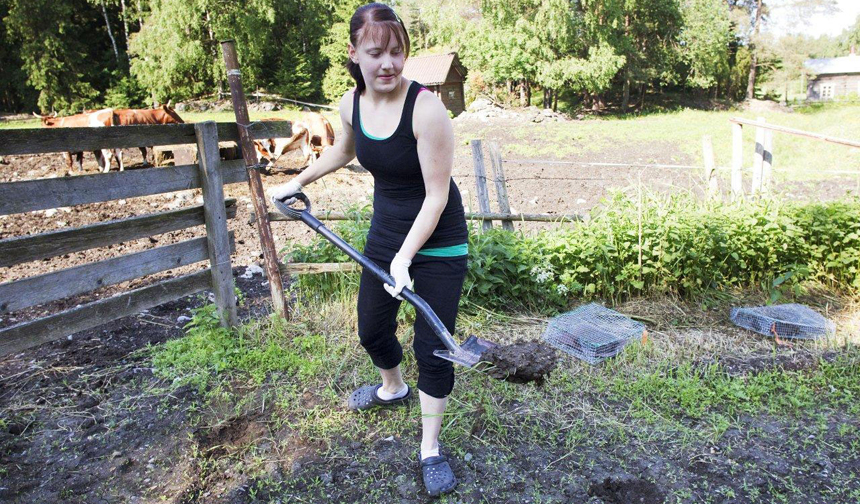Scooping poop for science
Finnish study enlists members of 4H for a study on cowpats

This 4H volunteer in Finland is scooping poop for science!
Timo Marttila, Satakunnan Kansa
Share this:
- Share via email (Opens in new window) Email
- Click to share on Facebook (Opens in new window) Facebook
- Click to share on X (Opens in new window) X
- Click to share on Pinterest (Opens in new window) Pinterest
- Click to share on Reddit (Opens in new window) Reddit
- Share to Google Classroom (Opens in new window) Google Classroom
- Click to print (Opens in new window) Print
You don’t have to work in a lab to help do science. You don’t even have to be a “scientist.” Everyone can contribute if they are willing to make careful observations. This may involve no more than going outside and counting birds or insects. If you live on a farm, you might even lend a hand scooping cow poop.
OK, the last option doesn’t sound glamorous. But it can help a good scientific cause. After all, have you ever wondered where cowpats go?
Once a cow poops, that smelly clump of semi-digested wastes falls to the grass. But come back a few months later and it will be gone. Where did it go? Some manure will have evaporated — but how much? And what happens to what doesn’t evaporate?
Scientists in Finland recruited young people from all over that country to get some answers. They recruited their helping hands from 4H. This large organization encourages rural kids to work on projects near their homes. Many 4H members live on or near farms. And many of those live near cows and the cowpats they drop. Those teens were in a perfect position to help the scientists.
Each 4H volunteer shoveled 5 gallons of manure from their farm or one nearby. Then they divided it into 15 separate cowpats. They laid each out on a nearby field and protected some from insects. The teen volunteers left other cowpats exposed. It may sound gross, but this hard work helped the scientists measure how much of an effect insects and other invertebrates (like worms) play in breaking down poop.
The teens’ data show that evaporation and microbes played the biggest role in removing cow poop. But how much disappeared depended in part on temperature. In Finland’s warmer South, 90 percent of the poop disappeared in just two summer months. At sites 1,100 kilometers (about 685 miles) further north, only three-quarters of the cowpats decomposed that quickly.
Insects played a role too. But it was fairly limited, the teens’ data show. Overall, regardless of temperature, insect feeding removed only about 13 out of every 100 grams of manure. One species — large dor beetles — were responsible for more than half of the poop removed by bugs. Dor beetles got rid of more than dung beetles and earthworms combined. Such findings highlight which insects we should be watching out for. You don’t want to harm poop-scooping beetles; you want to let them remove all the manure they can!
Tomas Roslin at the University of Helsinki, Finland, and his team published the findings this month in a professional research journal: Ecology.
Why recruit teens for research? The new work couldn’t have been done any other way, Roslin says. An ecologist, he headed the cowpat project. To do an experiment across an entire country, “you need to do it under the same conditions,” he explains. “You need to do it when the weather is the same, before seasons change.” With so many places to sample “there is no way that a single group could travel over such a distance! The only way you could do it is to have people already in place actually doing it for you.” And his 79 helpers in 4H were ready.
Across Finland, those teens weighed cowpats every 10 days. Then they tracked their data, writing it down (and later uploading it to a website). Each participant had to carefully protect the poop he or she was monitoring from being disturbed by people, cows — and sometimes even tractors. Roslin says “we simply could not have done it” without the teens’ careful data collection.
Such “crowd-sourcing” of data collection is known as citizen science. It depends on volunteers to provide researchers with data.
This wasn’t the first time Roslin recruited 4H volunteers for such work. In an earlier study, 4H teens observed hermit beetles. The threatened species lives in old oak trees. Teen volunteers used lab-made chemical smells to attract female beetles. The lure brought those insects out of hiding where they could be temporarily trapped and counted. Roslin and other researchers had initially thought there was only one population of hermit beetles in Finland. But the 4H volunteers turned up several more.
The Finnish scientists have loved getting volunteers involved. And they have plans to recruit more. By working with 4H members, Roslin hopes he will change how even rural teens view cowpats and the beetles thriving on them. Most 4H members will become farmers, he says. But if they remember parts of this project, he says — like that bugs keep the pastures green and growing as part of a farm ecosystem — “that’s great.” Some volunteers have even gone on to become scientists. Roslin has seen a few at his university.
You may not live in Finland, but that doesn’t mean you can’t volunteer to help out science. Look for projects on sites like SciStarter, which has lots of activities to choose from. Maybe you can listen to music for science, test how fair a coin toss really is or play online games. And your data may end up published in a journal, too!